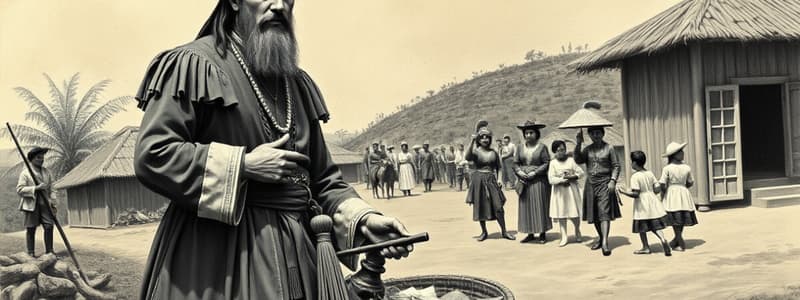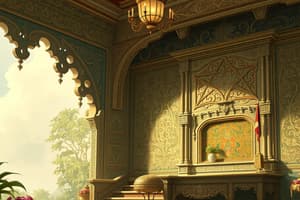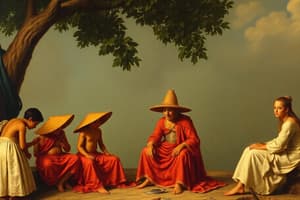Podcast
Questions and Answers
What is a key distinction between Aliping and Maharlica in terms of status inheritance?
What is a key distinction between Aliping and Maharlica in terms of status inheritance?
- Aliping can inherit land from their parents.
- Maharlica can lose their status by marrying a slave. (correct)
- Maharlica can be absorbed into their master's household.
- Aliping can become chiefs upon surpassing a certain age.
How can an Aliping potentially earn rewards from their master?
How can an Aliping potentially earn rewards from their master?
- By participating in community events.
- By obtaining rights to fish in chief's waters.
- By receiving a portion of the harvest. (correct)
- By cultivating their own land.
What happens to a wife’s belongings if she leaves her husband without plans to remarry?
What happens to a wife’s belongings if she leaves her husband without plans to remarry?
- All her dowry is returned to her. (correct)
- She must give up all personal items.
- She can keep half of the marital property.
- Her belongings are divided equally with her husband.
What principle governs land ownership among barangays as mentioned in the content?
What principle governs land ownership among barangays as mentioned in the content?
What consequence is there for individuals who do not belong to the chief's barangay when utilizing the fisheries?
What consequence is there for individuals who do not belong to the chief's barangay when utilizing the fisheries?
What term refers to the smallest division or unit of a city in the Philippines?
What term refers to the smallest division or unit of a city in the Philippines?
What does the historical classification of Natives in the Philippines indicate about their society?
What does the historical classification of Natives in the Philippines indicate about their society?
How were the Natives in the Philippines able to interact with other countries?
How were the Natives in the Philippines able to interact with other countries?
Which of the following best describes the situation of the Natives in the Philippines before the arrival of the Spanish?
Which of the following best describes the situation of the Natives in the Philippines before the arrival of the Spanish?
What historical references indicate the classification of Natives in the Philippines?
What historical references indicate the classification of Natives in the Philippines?
What was Fray Juan de Plasencia's family background?
What was Fray Juan de Plasencia's family background?
In which year did Fray Juan de Plasencia arrive in the Philippines?
In which year did Fray Juan de Plasencia arrive in the Philippines?
Which area did Fray Juan de Plasencia actively work to convert souls?
Which area did Fray Juan de Plasencia actively work to convert souls?
Which provinces are credited with the towns founded by Fray Juan de Plasencia?
Which provinces are credited with the towns founded by Fray Juan de Plasencia?
What happens to children in the case of adoption?
What happens to children in the case of adoption?
What characterized Fray Juan de Plasencia's life and work?
What characterized Fray Juan de Plasencia's life and work?
What role did Fray Juan de Plasencia play concerning the native population?
What role did Fray Juan de Plasencia play concerning the native population?
What does the term 'simbahan' refer to?
What does the term 'simbahan' refer to?
Which of the following is NOT a town founded by Fray Juan de Plasencia?
Which of the following is NOT a town founded by Fray Juan de Plasencia?
Which idol is considered the 'all powerful' for the Tagalogs?
Which idol is considered the 'all powerful' for the Tagalogs?
During which period was Fray Juan de Plasencia born?
During which period was Fray Juan de Plasencia born?
Which celestial body did the Tagalogs specifically name?
Which celestial body did the Tagalogs specifically name?
What is one role of the Catolonan priest?
What is one role of the Catolonan priest?
Which of the following is NOT one of the 12 Priests of the Devil?
Which of the following is NOT one of the 12 Priests of the Devil?
How did the Tagalogs view crocodiles?
How did the Tagalogs view crocodiles?
What is the significance of the feast that lasts for about 4 days?
What is the significance of the feast that lasts for about 4 days?
What do the Magtatangal do at night?
What do the Magtatangal do at night?
Which characteristic is associated with the Osuang?
Which characteristic is associated with the Osuang?
What action do tribesmen take when they witness certain omens?
What action do tribesmen take when they witness certain omens?
What is a common practice during the mourning of the deceased?
What is a common practice during the mourning of the deceased?
How did the document contribute to understanding Philippine history?
How did the document contribute to understanding Philippine history?
What belief system is depicted in the practices described?
What belief system is depicted in the practices described?
What function does the boat serve during burial practices?
What function does the boat serve during burial practices?
Which devil is said to know whether a soul can be saved or not?
Which devil is said to know whether a soul can be saved or not?
Flashcards are hidden until you start studying
Study Notes
Background of the Author: Juan de Plasencia
- Born in Plasencia, Extremadura, Spain, to the Portocarreros family in the early 16th century.
- Grew up during the Siglo de Oro, a period characterized by a flourishing of arts and literature in Spain.
Arrival in the Philippines
- Arrived in the Philippines on July 2, 1578, as part of the first group of Franciscan missionaries.
- Landed at a port in Cavite.
Various Assignments in the Philippines
- Began missionary work shortly after arrival, collaborating with Fray Diego de Oropesa.
- Focused on converting local populations around Laguna de Bay and Tayabas (now Quezon Province).
- Instrumental in founding numerous towns, including Tayabas, Caliraya, Lucban, and others in Bulacan and Rizal provinces.
- Recognized for a life dedicated to service, advocating for the rights of the indigenous population.
Social Structure and Property
- The barangay’s land areas were divided collectively, particularly irrigated sections.
- No cultivation by outsiders unless inherited or purchased land.
- Fishing privileges regulated by local chiefs, requiring payments for outsiders.
Adoration and Religious Practices
- Filipinos performed worship in the chief's large house, celebrating festivals that lasted several days.
- Key deities included Badhala, the "maker of all things," alongside various natural elements like the sun and moon.
- Notable idols included Dian Masalanta (patron of lovers) and idols representing agricultural patrons.
Priests of the Devil
- Defined roles for shamans with negative connotations, such as Catolonan and Mangagauay, involved in rituals and healing deceptions.
- Many were believed to possess supernatural abilities, including flying or casting charms.
Beliefs in Omens and Superstitions
- Filipinos believed in omens arising from daily experiences, shaping their decisions and fears regarding the future.
- Specific birds and other natural signs would evoke varying responses among the population.
Burial Customs
- The dead were mourned beside their homes for four days before being placed in a boat acting as a coffin.
- Celebratory eating and drinking followed mourning rituals, indicating a blending of grief and cultural tradition.
Significance to Philippine History
- Illustrates pre-colonial Philippine civilization as advanced with religious practices and social hierarchies before Spanish influence.
- Highlights the Philippines' cultural identity and social structures, demonstrating resilience and the ability to stand independently.
- The document’s relevance persists today, reflecting aspects of modern Filipino social organization and cultural practices.
Contemporary Relevance
- Some ancient norms remain influential, particularly the use of "barangay" in modern urban governance.
- Historical trade practices show early Filipino independence and interactions with other nations before colonialism.
Studying That Suits You
Use AI to generate personalized quizzes and flashcards to suit your learning preferences.




